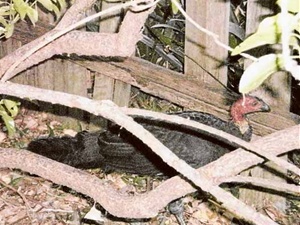Brush turkey seen in Oatley
On 6 April 2011, local paper The Leader published an article about a brush turkey in Oatley, giving mention to my sighting of it in Oatley Park.
Following enquiries with a bird expert wildlife carer, I determined it was the first recorded sighting of the species in Oatley Park, and the first sighting in Oatley since the 1800s - in at least 111 years!
My friend Peter co-incidentally saw it in the park an hour before me, but couldn't identify it, and we later worked out we'd both seen the same bird. See the short video of the brush turkey in Oatley Park on the WLMD Facebook page. It was taken using my phone.

Picture: Claudia Allison
BY MARIA GALINOVIC
IT HAS deep blue-black plumage, bright head colours, a broad, flat tail — and it has returned.
A brush turkey is causing some excitement around Oatley where it has been spotted strutting through the park and wandering in and out of nearby backyards.
Landscaper Matt Ellison saw it in his backyard in Lloyd Street, as did his daughter.
Chris Rehberg saw it wandering through Oatley Park.
"Although there are plenty of echidnas, wallabies, snakes and other wildlife gems like sacred kingfishers and spotted pardalotes, the turkey was a first," Mr Rehberg said.
Sharyn Cullis of Marine Drive saw it sprinting across the road.
"I thought I was going mad," she said.
"I heard scratching in the garden, saw the brush turkey, went to get my camera and found, of course, that it had disappeared.
"I was disappointed, until I looked above, and found it had settled high up in a gum tree."
Oatley Flora and Fauna Conservation Society president Julian Sheen said southern Sydney once would have been part of the turkey's original habitat, but it had not been seen recently and did not rate a mention in the society's list of 145 known bird species seen in Oatley Park.
"It was at home in the area in the past — and we rejoice in the fact that it is back home," Mr Sheen said.
"But we are in an urban setting where it could be a problem — although a bird on its own is not likely to cause any problems."
But problems could arise if a male bird decided to set up house in a backyard and start a family.
The bird scratches up the garden to build an incubation mound up to four metres wide and more than a metre high to attract a mate, which can lay between 18 and 24 eggs in the mound.
The female bird then leaves the male to look after the eggs.
He maintains a stable incubation temperature in the rotting vegetation by removing or adding layers to the mound. Before long, there is a family of turkeys.
Have you see the turkey near your place?